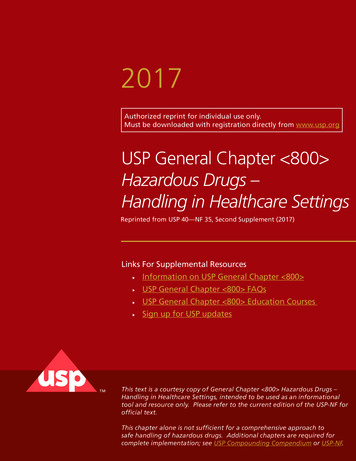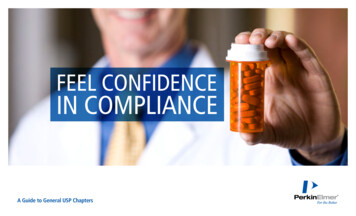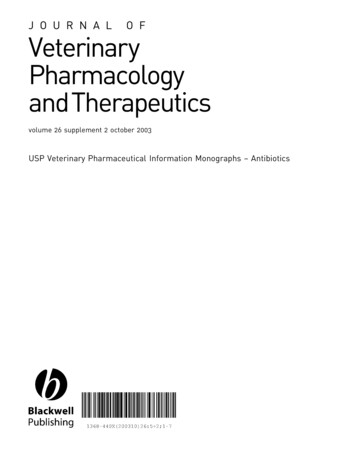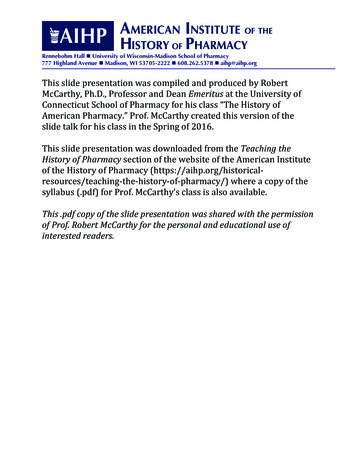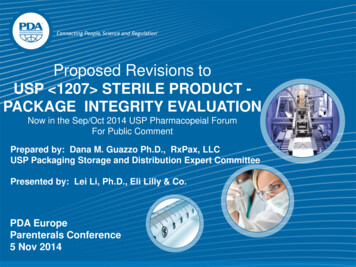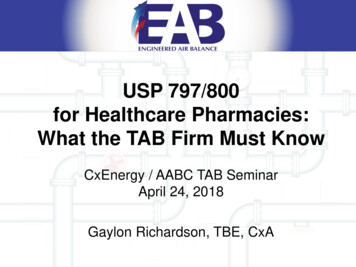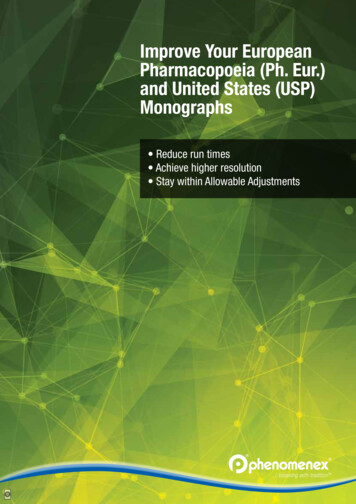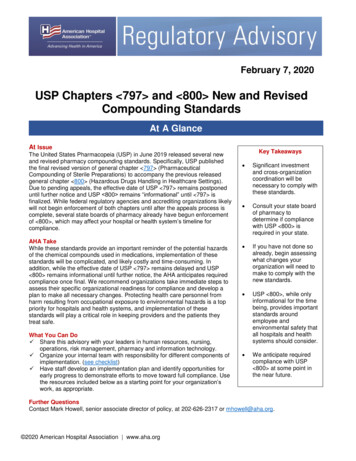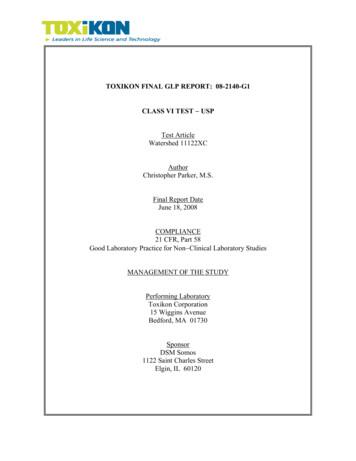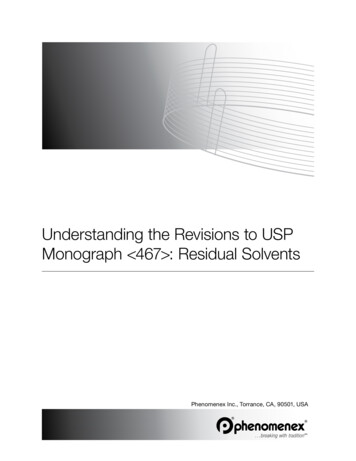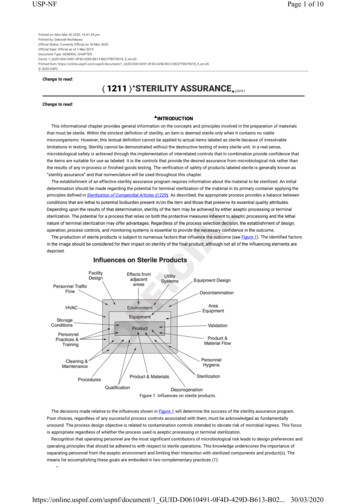
Transcription
USP-NFPage 1 of 10Printed on: Mon Mar 30 2020, 16:41:35 pmPrinted by: Deborah NishikawaOfficial Status: Currently Official on 30-Mar-2020Official Date: Official as of 1-Mar-2019Document Type: GENERAL CHAPTERDocId: 1 GUID-D0610491-0F4D-429D-B613-B027FB979018 5 en-USPrinted from: https://online.uspnf.com/uspnf/document/1 GUID-D0610491-0F4D-429D-B613-B027FB979018 5 en-US 2020 USPCChange to read:〈 1211 〉 STERILITY ASSURANCE USP41Change to read: INTRODUCTIONThis informational chapter provides general information on the concepts and principles involved in the preparation of materialsthat must be sterile. Within the strictest definition of sterility, an item is deemed sterile only when it contains no viablemicroorganisms. However, this textual definition cannot be applied to actual items labeled as sterile because of irresolvablelimitations in testing. Sterility cannot be demonstrated without the destructive testing of every sterile unit. In a real sense,microbiological safety is achieved through the implementation of interrelated controls that in combination provide confidence thatthe items are suitable for use as labeled. It is the controls that provide the desired assurance from microbiological risk rather thanthe results of any in-process or finished goods testing. The verification of safety of products labeled sterile is generally known as“sterility assurance” and that nomenclature will be used throughout this chapter.The establishment of an effective sterility assurance program requires information about the material to be sterilized. An initialdetermination should be made regarding the potential for terminal sterilization of the material in its primary container applying theprinciples defined in Sterilization of Compendial Articles 〈1229〉〉. As described, the appropriate process provides a balance betweenFigure 1). The identified factorsdepicted.Figure 1. Influences on sterile products.The decisions made relative to the influences shown in Figure 1 will determine the success of the sterility assurance program.Poor choices, regardless of any successful process controls associated with them, must be acknowledged as fundamentallyunsound. The process design objective is related to contamination controls intended to obviate risk of microbial ingress. This focusis appropriate regardless of whether the process used is aseptic processing or terminal sterilization.Recognition that operating personnel are the most significant contributors of microbiological risk leads to design preferences andoperating principles that should be adhered to with respect to sterile operations. This knowledge underscores the importance ofseparating personnel from the aseptic environment and limiting their interaction with sterilized components and product(s). Themeans for accomplishing these goals are embodied in two complementary practices (1): https://online.uspnf.com/uspnf/document/1 GUID-D0610491-0F4D-429D-B613-B02. 30/03/2020
USP-NFPage 2 of 10The use of automation technology—to reduce or eliminate personnel interventions and thus personnel-borne contamination The use of separative technologies—to eliminate, to the extent technically possible, human sourced contaminationThus the implementation of appropriate contamination control procedures is paramount in design and operation of sterile productmanufacturing systems.Consideration of these principles adapts the Quality by Design (QbD) approach widely adopted in regulatory standards (2–3).Using QbD concepts in sterile operations is markedly different from the applications in the typical formulation, pharmaceutical,chemical, or biological synthesis process. The establishment of direct linkage between a monitored condition and process outcomewith respect to sterile manufacturing is statistically difficult and analytically uncertain. The situation with respect to the definition ofphysical design elements is similar. Given the great variation in sterile product manufacturing with respect to scale, configuration,and complexity, it follows that the design alternatives and operating practices must also be flexible. Thus, the recommendationsprovided in this chapter are entirely non-numeric, because there are no ready means with which to demonstrate the suitability ofspecific values. Instead, QbD for sterile processing should be driven toward a singular goal of optimizing contamination control witha particular focus on the microbial risk impact of personnel. The specific means vary but should be of prime consideration in processdesign. Figure 2 outlines the elements that contribute to sterility assurance, as described in the remaining sections of this chapter.sequences required for complex items. Regardless of process scale, all of the individually sterilized materials must be protectedfrom contamination from the point of sterilization through closure of the primary package. This is accomplished through adherenceto the principles described below in which an International Organization for Standardization (ISO) 5 condition is maintained whenmaterials are exposed to the environment (see Microbiological Control and Monitoring of Aseptic Processing Environments 〈1116〉〉).Exclusive to aseptic processing is the execution of process simulations that support batch or campaign duration (4–6).Terminal SterilizationTerminally sterilized products are the lowest risk category of sterile pharmaceutical products. Unlike products asepticallymanufactured under conditions designed to prevent microbial ingress, terminally sterilized products are subjected to a sterilizationprocess that imparts a quantifiable safety level. Terminal sterilization processes achieve this by delivering measurable physicalconditions that correspond to microbial lethality. For terminally sterilized products, sterility assurance is defined in terms of theprobability of nonsterility (PNS), or the probability of the terminal sterilization process generating a nonsterile unit (PNSU). Terminalsterilization processes must achieve a consistent validated performance of a PNSU of 10 6 (a probability of NMT 1 nonsterile unit in1 million units produced) (see 〈1229〉〉). The convention by which terminal sterilization cycles are developed and validated ensuresthat the actual PNSU is typically much lower (better) than the minimum standard of 10 6.https://online.uspnf.com/uspnf/document/1 GUID-D0610491-0F4D-429D-B613-B02. 30/03/2020
USP-NFPage 3 of 10Chapter 〈1229〉〉 summarizes the common requirements for sterilization process design, development, validation, and processcontrol. Terminal sterilization processes share common requirements of well-defined process parameters strictly controlled withindefined operating limits. Terminal sterilization must be supported by a system of product disposition, which includes theassessment of critical physical process parameters, presterilization product parameters (e.g., bioburden, container–closureintegrity), and environmental parameters. Terminal sterilization can rely on parametric release practices to obviate the need forsterility testing (see Terminally Sterilized Pharmaceutical Products—Parametric Release 〈1222〉〉).Post-Aseptic Processing Terminal SterilizationAn aseptic process followed by a terminal sterilization process provides superior control over the presterilization bioburden, suchthat the subsequent sterilization process can be designed with less overall lethality, thereby making it possible to substantiallyextend the use of terminal sterilization to products with greater sensitivity to the applied energy of the process. From a patient safetyperspective, this approach has the following distinct advantages: An adventitious contaminant introduced during aseptic processing is easily killed by the terminal sterilization step, reducingthe extent of in-process environmental monitoring performed Bioburden controls for the terminal process are simplified because all units have been aseptically filled Where a product is made using either process alone, the limitations of each (no terminal lethal component in aseptic, moredegradation in terminal sterilization) would persist Where bioburden is controlled through aseptic processing, terminal sterilization can be applicable at lower lethality levelsClassical F0, time-temperature, and radiation dose (kGy) targets for sterilization processes are arbitrarily selected and intended tosimplify process validation, but in reality serve to reduce the use of terminal treatments. Physical lethality data based on fixed〈1229〉〉 and Moist Heatisolates. Cleanliness including freedom from particulates and absence of leachable or extractable chemicals Compatibility with the product Control over endotoxin content (where appropriate) Protection of components prior to use (where appropriate) Compatibility with preparation, sterilization, and depyrogenation processes (where appropriate)The essential aspects of container–closure materials for sterile products are subject to numerous requirements elsewhere withinUSP–NF. The reader must consider the content provided in Injections and Implanted Drug Products 〈1〉〉, Bacterial Endotoxins Test〈85〉〉, Visible Particulates in Injections 〈790〉〉, Package Integrity Evaluation—Sterile Products 〈1207〉〉, Depyrogenation 〈1228〉〉, and com/uspnf/document/1 GUID-D0610491-0F4D-429D-B613-B02. 30/03/2020
USP-NFPage 4 of 10Decontamination is a broadly defined term used to describe a variety of processes that reduce microbial populations without anexpectation for total kill.1 It is not a substitute for sterilization; a sterilization process should be used wherever possible. A variety ofchemical agents and methods are used that vary depending upon the application. Decontamination is used for bioburden reductionof materials, equipment, and environments in support of sterile product manufacture: For materials and surfaces that cannot be sterilized For materials and surfaces that do not require sterilizationDecontamination processes are ordinarily separated into two major categories based upon their effectiveness against sporeforming microorganisms (see Disinfectants and Antiseptics 〈1072〉〉). Sporicidal treatments are used in critical applications such asisolator decontamination, air-lock/pass-throughs, etc. Their toxicity to personnel and sometimes corrosive chemistry may precludetheir exclusive use for microbial control. Non-sporicidal agents have fewer safety and material impact concerns, and the occasionaluse of a sporicidal agent is required to control spore populations. Applications for decontamination are diverse; among the morecommon uses are:Decontamination of controlled environments and non-product contact surfaces In conventional cleanrooms, including restricted access barrier systems (RABS), this is predominantly a manual processperformed after cleaning of the room/production line Decontamination of items upon transition into an environment of higher classification Isolators commonly use an automated process Periodic decontamination of operator gloves during processingDecontamination of product contact surfaces robotics Be tolerant of variations in container–closure materials Designed to minimize product exposure to the background environmentThe extent to which the equipment interacts with process materials and the product affects the level of impact. Processequipment can influence the quality of the finished product in a variety of ways, and this can occur prior to and after sterilization anddepyrogenation.EQUIPMENT IN DIRECT CONTACT WITH COMPONENTS, CONTAINERS, CLOSURES, AND STERILE PRODUCTSThis equipment category includes those items in direct contact with the drug substance, drug product, raw materials, and primarypackaging components, including, for example, mixing and storage vessels, piping systems and tubing, filters, filling pumps,lyophilizer shelves, and feed hoppers. Product contact surfaces of this equipment are designed and may require additionaltreatment to minimize adverse impact (microbial, particulate, and chemical) on the contacted materials. The procedures used forthe cleaning and sterilization of direct contact surfaces, including dirty, clean, and sterile hold times, must be validated to ensurethey do not adversely impact essential product quality attributes as well as to verify the effectiveness of the cleaning procedure andhttps://online.uspnf.com/uspnf/document/1 GUID-D0610491-0F4D-429D-B613-B02. 30/03/2020
USP-NFPage 5 of 10that no microbial recontamination/proliferation occurs during equipment storage. Direct contact utensils are subject to the sameconsiderations. With appropriate consideration of materials' compatibility, single-use disposable equipment (supplied sterile whennecessary) may be utilized.EQUIPMENT HAVING INDIRECT CONTACT WITH COMPONENTS, CONTAINERS, CLOSURES, AND STERILE PRODUCTSEquipment having a significant impact on product quality, that does not contact components, primary packaging materials, andsterile products, includes the electro-mechanical elements (non-product contact) of filling machines, stoppering machines, andsterilizers. The performance of this equipment can change fill weight, particle size, moisture level, content uniformity, container–closure integrity, and other essential quality attributes. This equipment is ordinarily located near exposed product contactequipment surfaces. For example, a pre-assembled filling set (product contact equipment) may be installed on a filling machine(significant impact without product contact), which provides control over the fill volume or weight. The surfaces of this equipmentmust be compatible with the cleaning and microbial decontamination and/or sterilization agents employed.OTHER EQUIPMENTSome equipment has only an indirect impact on product quality, for example, conveyors, turntables, balances, air samplers, andcarts. The influence of this equipment is largely on the environments in which the product is made. The exposed surfaces of thisequipment must be compatible with the cleaning and decontamination agents used.FacilitiesSterile manufacturing operations are supported by administrative, laboratory, maintenance, and warehouse functions and otheractivities. The impact of these operations on the location and overall design of the sterile manufacturing area must be considered.Emphasis should be given in facility design to the flows of materials, components, personnel, equipment, and waste streamsthroughout the facility and to the orderly transition of items between environments of different classifications to prevent mix-up andavoid product contamination. Facility environmental and utility systems must be designed to minimize microbial, chemical, andparticulate contamination. The facility design must be supported by practices and procedures such as cleaning andEngineering's Baselineand finished materials.Table 1Processing TechnologyReferenceFDA AP 2004 (9), EMA AnnexConventional cleanroomISO 5–7ISO 5(10)Closed RABSISO 7ISO 5ISPE (11), PHSS (12)Open RABSISO 5ISO 5ISPE (11), PHSS (12)Closed isolatorsCNCaISO 5Open isolatorsCNC-ISO 8ISO 5PDA TR No. 34 (13), ISPE (7)Blow-fill-seal/form-fill-sealISO 5–7ISO 5(15)FDA AP 2004 (9), PDA TR No.34 (13), ISPE (7)FDA AP 2004 (9), PIC/S (14),FDA AP 2004 (9), Basemanhttps://online.uspnf.com/uspnf/document/1 GUID-D0610491-0F4D-429D-B613-B02. 30/03/2020
USP-NFPage 6 of 10Processing TechnologyBackground EnvironmentProcessing EnvironmentReferencePDA TR No. 28 (5); Agalloco,Closed systemsCNCNot applicablebHussong, et al. (16)Terminal sterilizationISO 8ISO 5–7EMA Annex (10)aControlled non-classified—a non-classified controlled environment with filtered air supply.bAs the process occurs with a closed system, there is no separate processing environment.[NOTE—Table values represent the operational condition and are adapted from the reference documents.]CONVENTIONAL CLEANROOMThe critical activities are performed in ISO 5 environments supported by surrounding ISO 5–7 environments where gownedpersonnel are normally located. There may be only limited separation between gowned personnel and sterile materials and productcontact surfaces. The critical activities are performed within a unidirectional airflow environment. Decontamination of thecleanroom is commonly performed by personnel.RESTRICTED ACCESS BARRIER SYSTEMSThe typical RABS provides ISO 5 unidirectional air within the barrier and is situated in a conventional ISO 5–7 cleanroom. RABSmay be designed to allow for opening of barriers to enable human intervention, or they may be designed to operate closed with thesame operational restrictions regarding operator access that applies to isolators (see below). Air overspill from within the barrier isdesigned to prevent the ingress of contamination. Operator manipulation of sterile items is achieved using glove ports, and materialtransfers are accomplished without opening the system. A RABS that is opened mid-process should be treated as a conventionalcleanroom (see above). RABSs require decontamination prior to use. This may be accomplished either manually or usingautomated systems.to use.performed by personnel.Materials (Active Pharmaceutical Ingredients, Excipients, and Process Aids)The preparation of sterile products encompass a wide range of materials including active pharmaceutical ingredients (small andlarge molecules), excipients, solvents (usually water), process gases and processing aids, all of which contribute to themicrobiological quality attributes of the product. Depending upon the product being manufactured, this can require consideration ofbacterial, endotoxin, and particulate contamination. Specific microbiological quality testing requirements for inactive and activeingredients testing is often specified in a relevant USP–NF monograph. Requirements for microbiological testing for total aerobicbacteria, yeast and mold counts, and specified organisms are given in Microbial Enumeration Tests 〈61〉 and Tests For SpecifiedMicroorganisms 〈62〉, and the recommended but non-mandatory enumeration targets for microbiological testing are given inMicrobiological Examination of Nonsterile Products: Acceptance Criteria for Pharmaceutical Preparations and Substances forPharmaceutical Use 〈1111〉. Some specific products may require other testing for specified organisms, including viruses, as arequirement of their regulatory approval. Requirements for bacterial endotoxin testing in injectable products are covered in 〈85〉,which describes qualification of Limulus amebocyte lysate testing for acceptable levels of bacterial endotoxin. Raw materialspecifications must be appropriate to ensure that the manufacturing process consistently results, as demonstrated through processvalidation, in products conforming to the microbiological critical quality attributes.Microbial contamination may be present on/in active pharmaceutical ingredients, excipients, and primary packaging materials.Controlling bioburden in materials and formulated product is a critical aspect of sterility assurance. The nature of the activehttps://online.uspnf.com/uspnf/document/1 GUID-D0610491-0F4D-429D-B613-B02. 30/03/2020
USP-NFPage 7 of 10pharmaceutical ingredient, the excipients, and the compounded product intended to be sterile are critical elements of the productknowledge. Recognizing the potential impact on critical quality attributes, the microbiological attributes of materials should becontrolled through adequate supplier controls, shipping, receipt, sampling, handling, and storage. These controls should becommensurate with the microbiological risks to process controls and sterile product safety. Laboratory results should not be utilizedto rationalize inadequate process controls on the part of the supplier.The potential impact of the materials on the microbiological critical quality attributes of presterilized and finished product must beassessed by evaluating them with appropriate compendial assays or validated alternatives. Risk assessment should consider theorigin of the material (e.g., fermentation, chemical synthesis, biologically derived, enzymatic, semi-synthetic synthesis, natural origin).Materials of biological origin may have higher inherent microbiological risk than materials derived solely from chemical synthesis.Materials may have inherent physicochemical properties that mitigate microbiological risks (e.g., low water activity, extreme pH,inherent antimicrobial properties) or increase microbiological risks (e.g., aqueous solution, growth supportive nutrients); this risk ofsupporting microbial proliferation must be assessed.MonitoringEnvironmental monitoring is employed to qualitatively assess the effectiveness of the design and operational controls to providesuitable facility hygiene. It is neither a substitute for good facility, equipment, and process design, nor compensation for deficientpractices and behavior. There are inherent limitations with all forms of viable and non-viable monitoring in terms of sample size,sample location, and recovery capability that preclude their use as anything more than an indication that a facility is operating withinan acceptable state of control. Monitoring provides only a snapshot in time of the actual environmental conditions and excessivesampling due to its potentially intrusive nature can actually impair product safety or generate counts unrelated to processperformance by increasing activity proximate to the critical zone.Independent of air, surface, and personnel monitoring, media fills and sterility testing provide additional (albeit analytically andstatistically limited) means to evaluate the robustness of the cleanroom design, performance, and effectiveness ofcleaning/decontamination procedures, personnel gowning integrity, and aseptic practices.variety of methods including: Active air sampling Passive air sampling Swabbing of surfaces Personnel monitoringcleanroom in accordance with ISO 14644-1 and to assess routine manufacturing conditions (8). When used for the purposes ofmonitoring, it can be performed under static conditions (no activity) and/or dynamic conditions (routine operation). Non-viableparticle monitoring is performed using calibrated particle counters.MEDIA FILLS/ASEPTIC PROCESS SIMULATIONSProcess simulations are exercises in which the performance of an aseptic activity is evaluated using a sterile growth medium.The medium can be directly substituted for the product or added to it. Aseptic process simulations are typically performed beforethe introduction of new or revised process components (e.g., products, facilities, equipment, personnel, containers and closures,and processes) and periodically thereafter (17). Process simulations should be fully representative of processing conditions andactivities utilized during routine production.STERILITY TESTINGThe sterility test is a harmonized compendial test. It must be understood that while execution of the test is required for therelease of sterile products where parametric release has not been approved, it cannot prove the sterility of the materials tested. Itshould be recognized that parametric release is the default mode of sterile product cument/1 GUID-D0610491-0F4D-429D-B613-B02. 30/03/2020
USP-NFPage 8 of 10Personnel play an essential role in the preparation of sterile products. The essential activities they perform include cleaning,assembly, equipment operation, material transfer, environmental monitoring, and decontamination. While personnel are oftennecessary for the performance of these activities, the contamination derived from them must be prevented from entering theproduction materials before and after sterilization. The importance of the controls necessary to minimize exposure to and therelease of human microbial contaminants in a sterile product manufacturing environment cannot be overstated.The personnel involved in the preparation of sterile products must: Understand the principles of microbiology, sterilization/depyrogenation, aseptic processing, and contamination control Be proficient and diligent in gowning practices. Personnel required to wear aseptic gowning should periodically demonstratetheir ability to properly gown Adhere to proper aseptic technique during all aseptic activities even when these are performed in a RABS or isolator. Periodicdemonstration of these skills can be beneficial Be familiar with and adhere to standard operating procedures Practice good personal hygiene to minimize contamination potential Be trained in the proper and safe operation of necessary equipment Be monitored microbiologically after performing aseptic operationsProceduresprocedures.1.2.frequency of inherent interventions and making all interventions easier to perform3.Interventions should be designed for minimal risk of contaminating sterile and nonsterile materials4.All interventions should be performed using sterilized tools whenever possible5.Intervention procedures should be established in detail for all inherent interventions, and more broadly for correctiveinterventions (where some flexibility is necessary due to greater diversity)6.Interventions should be incorporated in periodic media fills to evaluate the aseptic practices of the operatorsOperators should initially, and periodically thereafter, be trained in all of the procedures they are expected to perform.Considerations for operator activity during the non-aseptic filling of containers should parallel those described above to minimizethe potential for contamination ingress with somewhat less rigor than those needed for aseptic operations.SterilizationThe most effective means for the control of microbial population is sterilization, a process that either kills or removes viablemicroorganisms. In the production of sterile products, sterilization processes are used to prevent microbial contamination. Terminalhttps://online.uspnf.com/uspnf/document/1 GUID-D0610491-0F4D-429D-B613-B02. 30/03/2020
USP-NFPage 9 of 10sterilization processes that reproducibly destroy microorganisms in the final product container are the preferred means for theproduction of sterile products. Sterile products that cannot be terminally sterilized rely on individual sterilization processes (e.g.,steam, radiation gas, filtration) for the various materials that comprise an aseptically processed sterile product. In addition,sterilization processes are used for product contact and other non-product contact items used in a variety of applications during thepreparation of sterile products to provide absolute control of bioburden. Details on sterilization processes are provided in 〈1229〉.UtilitiesThe manufacture of sterile products requires utilities that can have a substantial impact on the final product. Some of the utilitiesin the facility can become an integral part of the formulated product (e.g., Water for Injection, Nitrogen) and appropriate design of theproduction and distribution system for these is essential. The systems for these are tightly controlled and frequent monitoring of theutilities produced is customary. These utilities may be also used in the process, and not become a part of the sterile product. Otherutilities (e.g., clean steam, compressed air, Purified Water) that are used in the cleaning/decontamination of facilities, and/orpreparation of equipment, containers, and closures can also be subjected to microbial control.Utilities included in the product, in direct product contact, and in the preparation of equipment, containers, closures, and otheritems must meet the requirements defined in the appropriate USP–NF monograph. The systems for their preparation should besubject to formalized controls that maintain a controlled state over time. This is accomplished through a number of related practicesessential for continued use of the system over an extended time. The essential practices to maintain controlled status of the utilitysystems include: calibration, change control, corrective and preventive maintenance, and ongoing process control.There are other less impactful utilities (e.g., vacuum, cooling water) necessary for the operation of the facility and equipment.Although these non-product contact utilities may lack monograph requirements, their reliable operation is necessary for consistentproduction of sterile products.SUMMARYThe safety of products labeled sterile requires that their critical quality attributes consistently meet specifications. Sterility is the).compendium (Sterility Tests 〈“sterility” of the whole.1.2.—FDAperspective. FDA Quality Initiative Workshop at International Society for Pharmaceutical Engineering Meeting. 2007 Feb 28.3.International Council for Harmonisation of Technical Requirements for Registration of Pharmaceuticals for Human Use (ICH).Pharmaceutical development, Q8 (R2). Geneva: ICH; August 2009.4.Parenteral Drug Association. Process simulation for aseptically filled products. PDA Technical Report No. 22, revision.Philadelphia: PDA; 2011.5.Parenteral Drug Association. Process simulation testing for sterile bulk pharmaceutical chemicals. PDA Technical Report No.28, revised. PDA J Pharm Sci Technol. Vol. 60, Supplement S-2, 2006.6.Parenteral Drug Association. Recommended practices for manual aseptic filling. PDA Technical Report No. 62. Philadelphia:PDA; 2013.7.International Society for Pharmaceutical Engineering. ISPE Baseline Guide, Volume 3: Sterile Product Manufacturing Facilities(latest revision). Bethesda, MD: ISPE; 2011.https://online.uspnf.com/uspnf/document/1 GUID-D0610491-0F4D-429D-B613-B02. 30/03/2020
USP-NFPage 10 of 10International Organization for Standardization. ISO 14644: Cleanrooms and associated controlled environments.9.Food and Drug Administration. Guidance for industry. Sterile drug products produced by aseptic processing. Rockville, MD:FDA; 2004.10.European Medicines Agency. Annex 1, Sterile Medic
Printed on: Mon Mar 30 2020, 16:41:35 pm Printed by: Deborah Nishikawa Official Status: Currently Official on 30-Mar-2020 Official Date: Official as of 1-Mar-2019
